Charles E W Bean, Diaries, AWM38 3DRL 606/267/1 - 1914 - 1915 - Part 2
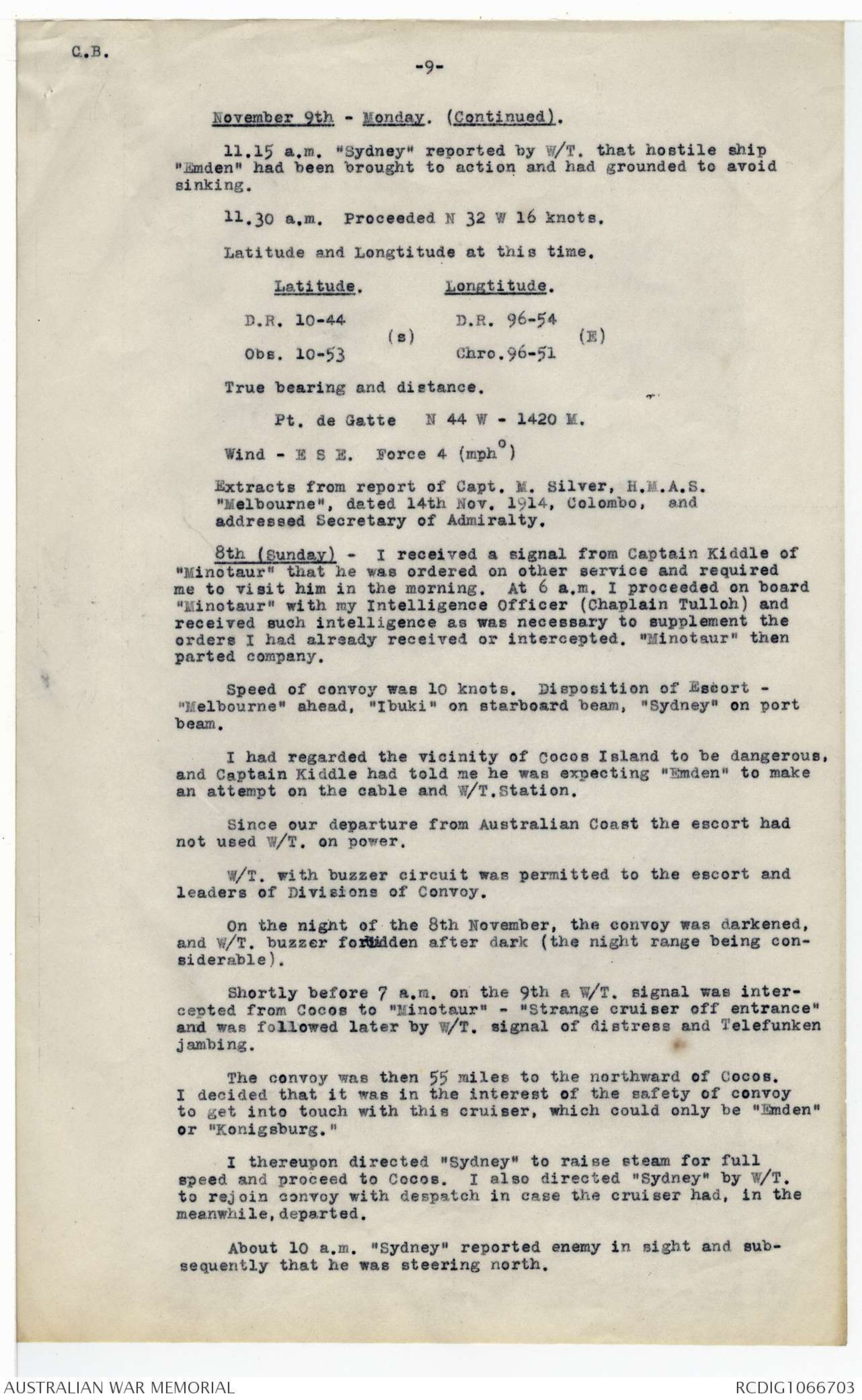
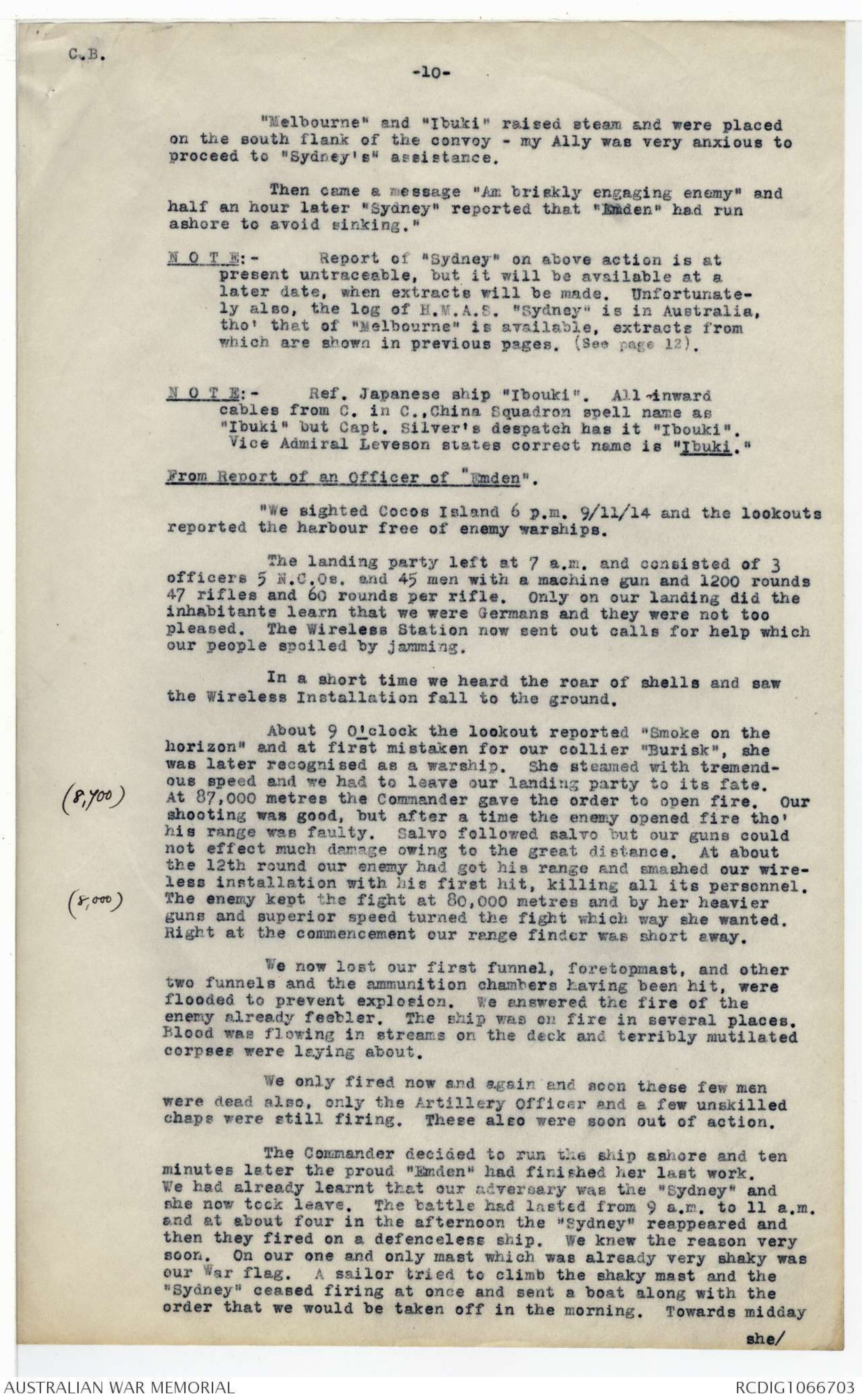
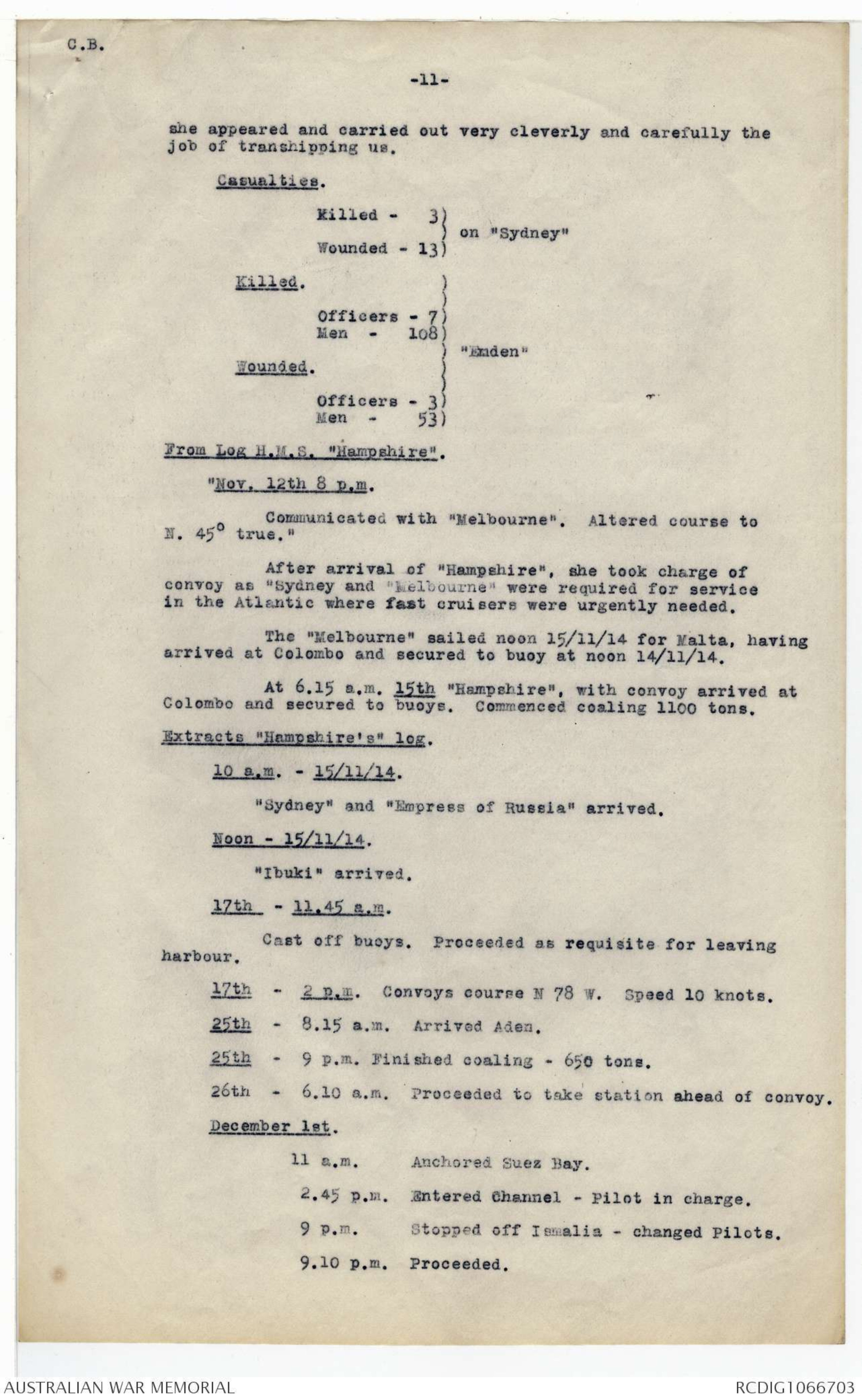



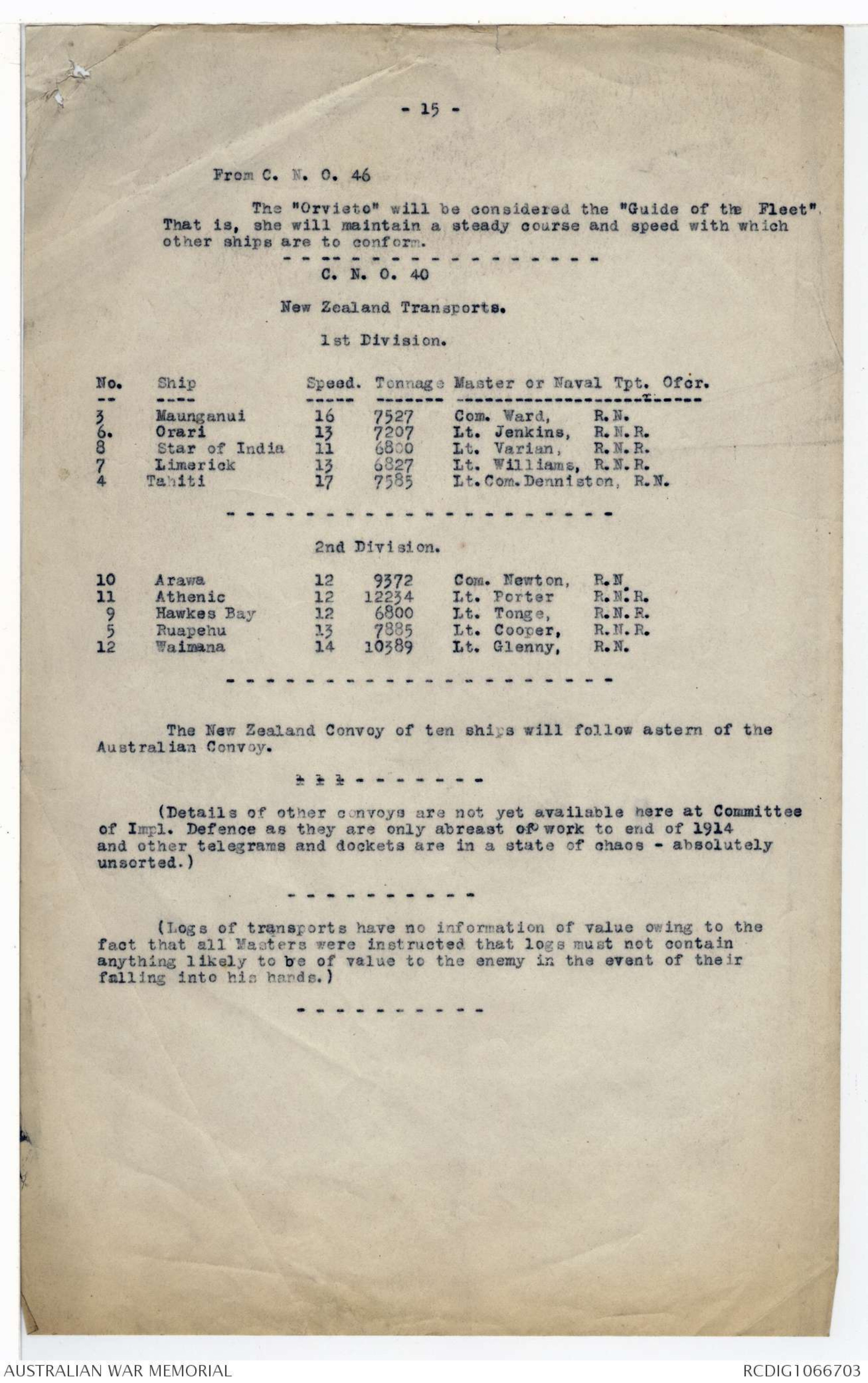
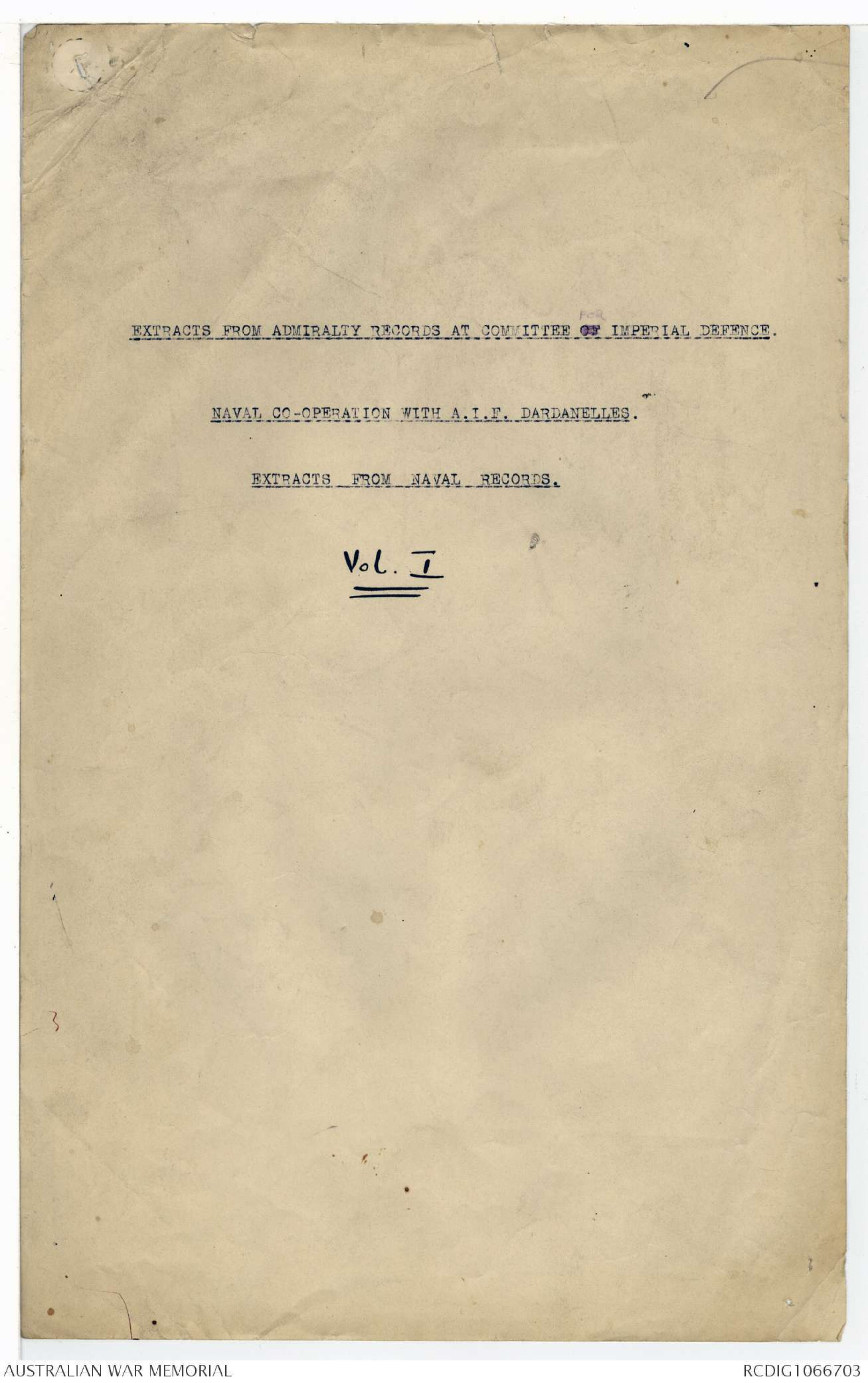
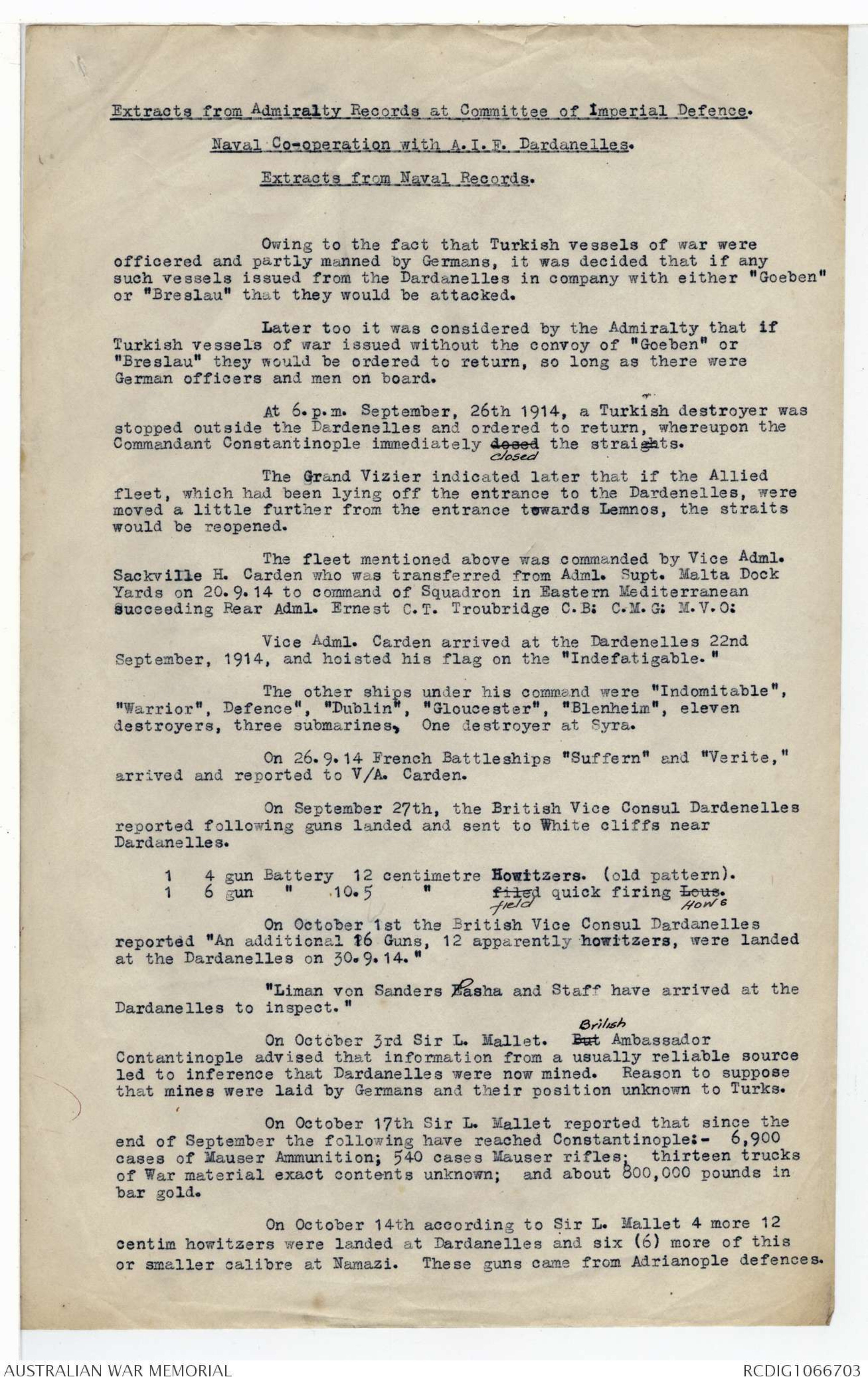

C.B.
-9-
November 9th - Monday. (Continued).
11.15 a.m. "Sydney" reported by W/T that hostile ship
"Emden" had been brought to action and had grounded to avoid
sinking.
11.30 a.m. Proceeded N 32 W 16 knots.
Latitude and Longtitude at this time.
Latitude. Longtitude.
D.R. 10-44 D.R. 96-54
(s) (E)
Obs. 10-53 Chro. 96-51
True bearing and distance.
Pt. de Gatte N 44 W - 1420 M.
Wind - E S E. Force 4 (mpho)
Extracts from report of Capt. M. Silver, H.M.A.S.
"Melbourne", dated 14th Nov. 1914, Colombo, and
addressed Secretary of Admiralty.
8th (Sunday) - I received a signal from Captain Kiddle of
"Minotaur" that he was ordered on other service and required
me to visit him in the morning. At 6 a.m. I proceeded on board
"Minotaur" with my Intelligence Officer (Chaplain Tulloh) and
received such intelligence as was necessary to supplement the
orders I had already received or intercepted, "Minotaur" then
parted company.
Speed of convoy was 10 knots. Disposition of Escort -
"Melbourne" ahead, "Ibuki" on starboard beam, "Sydney" on port
beam.
I had regarded the vicinity of Cocos Island to be dangerous,
and Captain Kiddle had told me he was expecting "Emden" to make
an attempt on the cable and W/T. Station.
Since our departure from Australian Coast the escort had
not used W/T. on power.
W/T. with buzzer circuit was permitted to the escort and
leaders of Divisions of Convoy.
On the night of the 8th November, the convoy was darkened
and W/T. buzzer forbidden after dark (the night range being considerable).
Shortly before 7 a.m. on the 9th a W/T. signal was intercepted
from Cocos to "Minotaur" - "Strange cruiser off entrance"
and was followed later by W/T. signal of distress and Telefunken
jambing.
The convoy was then 55 miles to the northward of Cocos.
I decided that it was in the interest of the safety of convoy
to get into touch with this cruiser, which could only be "Emden"
or "Konigsburg."
I thereupon directed "Sydney" to raise steam for full
speed and proceed to Cocos. I also directed "Sydney" by W/T.
to rejoin convoy with despatch in case the cruiser had, in the
meanwhile, departed.
About 10 a.m. "Sydney" reported enemy in sight and subsequently
that he was steering north.
C.B.
-10-
"Melbourne" and "lbuki" raised steam and were placed
on the south flank of the convoy - my Ally was very anxious to
proceed to "Sydney's" assistance.
Then came a message "Am briskly engaging enemy" and
half an hour later "Sydney" reported that "Emden" had run
ashore to avoid sinking."
N O T E: - Report of "Sydney" on above action is at
present untraceable, but it will be available at a
later date, when extracts will be made. Unfortunately
also, the log of H.M.A.S. "Sydney" is in Australia,
tho' that of "Melbourne" is available, extracts from
which are shown in previous pages. (See page 12).
N O T E: - Ref. Japanese ship "Ibouki". All inward
cables from C. in C., China Squadron spell name as
"Ibuki" but Capt. Silver's despatch has it "Ibouki".
Vice Admiral Leveson states correct name is "Ibuki."
From Report of an Officer of "Emden".
"We sighted Cocos Island 6 p.m. 9/11/14 and the lookouts
reported the harbour free of enemy warships.
The landing party left at 7 a.m. and consisted of 3
officers 5 N.C.Os, and 45 men with a machine gun and 1200 rounds
47 rifles and 60 rounds per rifle. Only on our landing did the
inhabitants learn that we were Germans and they were not too
pleased. The Wireless Station now sent out calls for help which
our people spoiled by jamming.
In a short time we heard the roar of shells and saw
the Wireless Installation fall to the ground.
About 9 O'clock the lookout reported "Smoke on the
horizon" and at first mistaken for our collier "Burisk", she
was later recognised as a warship. She steamed with tremendous
speed and we had to leave our landing party to its fate.
[*(8,700)*]
At 87,000 metres the Commander gave the order to open fire. Our
shooting was good, but after a time the enemy opened fire tho'
his range was faulty. Salvo followed salvo but our guns could
not effect much damage owing to the great distance. At about
the 12th round our enemy had got his range and smashed our wireless
installation with his first hit, killing all its personnel.
[*(8,000)*]
The enemy kept the fight at 80,000 metres and by her heavier
guns and superior speed turned the fight which way she wanted.
Right at the commencement our range finder was short away.
We now lost our first funnel, foretopmast, and other
two funnels and the ammunition chambers having been hit, were
flooded to prevent explosion. We answered the fire of the
enemy already feebler. The ship was on fire in several places.
Blood was flowing in streams on the deck and terribly mutilated
corpses were laying about.
We only fired now and again and soon these few men
were dead also, only the Artillery Officer and a few unskilled
chaps were still firing. These also were soon out of action.
The Commander decided to run the ship ashore and ten
minutes later the proud "Emden" had finished her last work.
We had already learnt that our adversary was the "Sydney" and
she now took leave. The battle had lasted from 9 a.m. to 11 a.m.
and at about four in the afternoon the "Sydney" reappeared and
then they fired on a defenceless ship. We knew the reason very
soon. On our one and only mast which was already very shaky was
our War flag. A sailor tried to climb the shaky mast and the
"Sydney" ceased firing at once and sent a boat along with the
order that we would be taken off in the morning. Towards midday
she/
C.B.
-11-
she appeared and carried out very cleverly and carefully the
job of transhipping us.
Casualties.
Killed - 3}
} on "Sydney"
Wounded - 13}
Killed. }
Officers - 7 }
Men - 108 }
} "Emden"
Wounded. }
Officers - 3 }
men - 53 }
From Log H.M.S "Hampshire".
"Nov. 12th 8 p.m.
Communicated with "Melbourne". Altered course to
N. 45o true."
After arrival of "Hampshire", she took charge of
convoy as "Sydney and "Melbourne" were required for service
in the Atlantic where fast cruisers were urgently needed.
The "Melbourne" sailed noon 15/11/14 for Malta, having
arrived at Colombo and secured to buoy at noon 14/11/14.
At 6.15 a.m. 15th "Hampshire", with convoy arrived at
Colombo and secured to buoys. Commenced coaling 1100 tons.
Extracts "Hampshire's" log.
10 a.m. - 15/11/14.
"Sydney" and "Empress of Russia" arrived.
Noon - 15/11/14.
"Ibuki" arrived.
17th - 11.45 a.m.
Cast off buoys. Proceeded as requisite for leaving
harbour.
17th - 2 p.m. Convoys course N 78 W. Speed 10 knots.
25th - 8.15 a.m. Arrived Aden.
25th - 9 p.m. Finished coaling - 650 tons.
26th - 6.10 a.m. Proceeded to take station ahead of convoy.
December 1st.
11 a.m. Anchored Suez Bay.
2.45 p.m. Entered Channel - Pilot in charge.
9 p.m. Stopped off Ismalia - changed Pilots.
9.10 p.m. Proceeded.
C.B.
-12-
December 2nd.
2 a.m. Arrived Port Said.
3 p.m. German prisoners of war from S.S. "Orvieto” and
"Maunganui" joined ship.
N O T E: - These prisoners of war were captured in the "Sydney"- "Emden"
action.
Cairo cabled 1/12/14 "All Australian and New Zealand convoys
have arrived," and G.O.C., Egypt, under date 15/12/14 advised the War
Office "We have completed disembarkation of the Australian and New
Zealand Contingents at Alexandria."
Thursday - 3/12/14 - "Hampshire" sailed 6.40 a.m, for Malta under
Admiralty instructions en route to Gibralter.
"SYDNEY'S" REPORT OF "EMDEN" FIGHT.
Despatch from Captain Glossop to Secretary, Admlty.
H.M.A.S. "Sydney" at Colombo, - 15th November, 1914.
"I have the honour to report that whilst on escort duty
with the Convoy under the charge of Captain Silver, H.M.A.S. "Melbourne"
at 6.20 a.m. on Monday, 9th November, a wireless message from Cocos was
heard reporting that a foreign warship was off the entrance.
I was/ordered to raise steam for full speed at 7 a.m. and
proceeded thither. I wrked up to 20 knots and at 9.15 a.m. sighted land
ahead and almost immediately the smoke of a ship, which proved to be
H.I.G.M.S. "Emden" coming towards me at a great rate. At 9.40 a.m. fire
was opened, she firing the first shot.
I kept my distance as much as possible to obtain the advantage
of my guns. Her fire was very rapid and accurate to begin with,
but seemed to slacken very quickly, all casualties occurring in this ship
almost immediately.
First the foremost funnel of her went, secondly the
foremast, and she was badly on fire aft, then the second funnel went,
and lastly the third funnel, and I saw she was making for the beach on
North Kelling Island, where she grounded at 11.20 a.m. I gave her two
more broadsides and left her to pursue a merchant ship which had come up
during the action.
2. Although I had guns on this merchant ship at odd times
during the action, I had not fired, and as she was making off fast, I
pursued and overtook her at 12.10 firing a gun across her bows and hoisting
International Code Signal to stop, which she did. I sent an armed
boat and found her to be S.S. "Buresk", a captured British collier with
18 Chinese crew, 1 English Steward, 1 Norwegian Cook, and a German prize
crew of 3 officers, 1 Warrant Officer and 12 men. The ship unfortunately
was sinking, the kingston knocked out and damaged to prevent repairing,
so I took all on board, fired 4 shells into her and returned to the
"Emden" passing men swimming in the water for whom I left 2 boats I was
towing from "Buresk".
3. On arriving again off "Emden" she still had her colours up
at the mainmast head. I enquired by signal Internal Code "Will you
surrender?" and received a reply in Morse "What signal" to signal books".
I then made in Morse "Do you surrender" and subsequently "Have you received
my signal" to neither of which did I get an answer. The German Officers on
board gave me to understand that the Captain would never surrender, and
therefore, tho' very relucantly, I again fired at her at 4.30 p.m, ceasing
at 4.35 p.m. as she showed white flags and hauled down her ensign by sending
a man aloft.
C.B.
-13-
4. I then left the "Emden" and returned and picked up the
"Buresk's" two boats, rescuing 2 sailors (5 p.m.) who had been in the
water all day. I returned and sent in one boat to "Emden" manned by
her own prize crew from "Buresk" and 1 officer and stating I would return
to their assistance next morning.
This I had to do as I was desirous to find out the condition
of cables and wireless station at Direction Island.
On thepassage over I was again delayed by rescuing another
sailor (6.30 p.m.) and by the time I was again ready and approaching
Direction Island it was too late for the night.
5. I lay on and off all night and communicated with Direction
Island at 8 a.m. 10th November to find that the "Emden" party consisting
of 3 officers and 40 men, 1 launch and two cutters had siezed and
provisioned a 70 tons schooner (the "Ayesha") having 4 maxims with 2
belts to each. They left the previous night at six o'clock. The
wireless station was entirely destroyed, 1 cable cut, 1 damaged, and 1
intact. I borrowed a Doctor and 2 Assistants, and proceeded as fast as
possible to "Emden" assistance.
6. I sent an officer on board to see the Captain and in view of
the large number of prisoners and wounded and lack of accommodation, etc.,
on this ship and the absolute impossibility of leaving them where they were,
he agreed that if I received his officers and men and all wounded, then as
for such time as they remained in "Sydney" they would cause no interference
with ship or fittings and would be amenable to the ship's discipline. I
therefore set to work at once to tranship them - a most difficult operation,
the ship being on the weather side of Island and the sea alongside very
heavy. The conditions in the "Emden" were indescribable. I received the
last from her at 5 p.m. then had to go round to the lee-side to pick up 20
more men who had managed to get ashore from the ship.
7. Darkness came on before this could be accomplished and the ship
again stood off and on all night, resuming operations at 5 a.m. on 11th
November, a cutter's crew having to land with stretchers to bring wounded
round to embarking point. A German officer, a doctor, died ashore the previous
day. The ship in the meantime ran over to Direction Island, to return
their Doctor and assistants, send cables, and was back again at 10 a.m.,
embarked the remainder of wounded and proceeded for Colombo by 10.35 a.m.,
Wed., 11th November.
8. Total casualties in "Sydney" - killed 3, severely wounded
(since dead) 1, severely wounded 4, wounded 4, slightly wounded 4.
9. The damage to "Sydney's" hull and fittings was surprisingly
small; in all about 10 hits seem to have been made. The engine and boiler
rooms and funnels escaped entirely.
(Here paras, 10 to 12 inc. have been deleted from this report
published in a supplement to the London Gazette of 29th Dec.,
1914, and these will only be available when the original report
is found.)
(Missing paras. deal with the effect of gun fire of both
"Sydney" and "Emden").
- 14-
ORGANIZATION OF CONVOY.
Extract from "Convoy Naval Orders" issued by A. Gordon Smith, Captain
in charge of Convoy.
C. N. O. 9
The convoy will be organised as follows :
|
1st Division. |
|||||
|
Distinguishing Signals |
Transport No. | Fleet No. | Name | Tonnage | Speed |
|
(Flag of G. O. C.) |
|||||
| AVB. | A3 | 1 | Orvieto | 12130 | 15 |
| AVC. | A27 | 2 | Southern | 4769 | 10½ |
| AVD. | A4 | 3 | Pera | 7635 | 11 |
| AVE | A26 | 4 | Armadale | 6153 | 11 |
| AVF. | A12 | 5 | Saldanha | 4594 | 11 |
| AVG. | A13 | 6 | Katuna | 4641 | 11 |
| AVH. | A1 | 7 | Kymettus | 4606 | 11 1/2 |
| AVI. | A23 | 8 | Suffolk | 7573 | 12 |
| AVJ | A25 | 9 | Anglo-Egyptian | 7379 | 12 |
|
2nd Division. (Division Leader) |
|||||
| AWB. | A18 | 10 | Wiltshire | 10390 | 14 |
| AWC. | A7 | 11 | Medic | 12032 | 13 |
| AWD. | A11 | 12 | Ascanius | 10048 | 13 |
| AWE. | A15 | 13 | Star of England | 9150 | 13½ |
| AWF. | A2 | 14 | Geelong | 2951 | 12 |
| AWG. | A17 | 15 | Port Lincoln | 7243 | 12 |
| AWH. | A10 | 16 | Karoc | 6127 | 12 |
| AWI. | A21 | 17 | Marere | 6443 | 12½ |
| AWJ. | A6 | 18 | Clan MacCorquodale | 5058 | 12½ |
|
(Division Leader) |
|||||
| AXB. | A14 | 19 | Euripides | 14947 | 15 |
| AXC. | A8 | 20 | Argyllshire | 10392 | 14 |
| AXD. | A9 | 21 | Shropshire | 11911 | 14 |
| AXE. | A19 | 22 | Afric. | 11999 | 13 |
| AXF. | A24 | 23 | Benalla | 11118 | 14 |
| AXG. | A22 | 24 | Rangatira | 10118 | 14 |
| AXH. | A16 | 25 | Star of Victoria | 9152 | 13½ |
| AXI. | A20 | 26 | Hororata | 9491 | 14 |
| AXJ. | A5 | 27 | Omrah | 8130 | 15 |
| AXK. | A28 | 28 | Miltiades | 7814 | 13 |
C. N. O. 10. (Extracts)
General procedure of Convoy:
1. The convoy will proceed at sea in three divisions. The first
in the centre, the second division to port, and the third
division to starboard of the first division.
2. Divisions include as far as possible ships of equal speed,
first Division the slowest and the 3rd Division the fastest vessels.
3. Leaders of divisions will be abeam of the "Orvieto" and one
mile distant unless otherwise ordered.
-15-
From C. N. O. 46
The "Orvieto" will be considered the "Guide of the Fleet"
That is, she will maintain a steady course and speed with which
other ships are to conform.
C. N. O. 40
New Zealand Transports.
|
1st Division. |
|||||
| No. | Ship | Speed. | Tonnage | Master or Naval Tpt. Ofcr. | |
| 3 | Maunganui | 16 | 7527 | Com. Ward, | R.N. |
| 6. | Orari | 13 | 7207 | Lt. Jenkins, | R.N.R. |
| 8 | Star of India | 11 | 6800 | Lt. Varian, | R.N.R. |
| 7 | Limerick | 13 | 6827 | Lt. Williams, | R.N.R. |
| 4 | Tahiti | 17 | 7585 | Lt.Com. Denniston, | R.N. |
|
2nd Division. |
|||||
| 10 | Arawa | 12 | 9372 | Com. Newton, | R.N. |
| 11 | Athenic | 12 | 12234 | Lt. Porter | R.N.R. |
| 9 | Hawkes Bay | 12 | 6800 | Lt. Tonge, | R.N.R. |
| 5 | Ruapehu | 13 | 7885 | Lt. Cooper, | R.N.R. |
| 12 | Waimana | 14 | 10389 | Lt. Glenny, | R.N. |
The New Zealand Convoy of ten ships will follow astern of the
Australian Convoy.
(Details of other convoys are not yet available here at Committee
of Impl. Defence as they are only abreast of work to end of 1914
and other telegrams and dockets are in a state of chaos - absolutely
unsorted.)
(Logs of transports have no information of value owing to the
fact that all Masters were instructed that logs must not contain
anything likely to be of value to the enemy in the event of their
falling into his hands.)
EXTRACTS FROM ADMIRALTY RECORDS AT COMMITTEE OF FOR IMPERIAL DEFENCE.
NAVAL CO-OPERATION WITH A.I.F. DARDANELLES.
EXTRACTS FROM NAVAL RECORDS.
Vol. I
Extracts from Admiralty Records at Committee of Imperial Defence.
Naval Co-operation with A.I.F. Dardanelles.
Extracts from Naval Records.
Owing to the fact that Turkish vessels of war were
officered and partly manned by Germans, it was decided that if any
such vessels issued from the Dardanelles in company with either "Goeben"
or "Breslau" that they would be attacked.
Later too it was considered by the Admiralty that if
Turkish vessels of war issued without the convoy of "Goeben" or
"Breslau" they would be ordered to return, so long as there were
German officers and men on board.
At 6.p.m. September, 26th 1914, a Turkish destroyer was
stopped outside the Dardenelles and ordered to return, whereupon the
Commandant Constantinople immediately desed closed the straights.
The Grand Vizier indicated later that if the Allied
fleet, which had been lying off the entrance to the Dardenelles, were
moved a little further from the entrance towards Lemnos, the straits
would be reopened.
The fleet mentioned above was commanded by Vice Adml.
Sackville H. Carden who was transferred from Adml. Supt. Malta Dock
Yards on 20.9.14 to command of Squadron in Eastern Mediterranean
succeeding Rear Adml. Ernest C.T. Troubridge C.B: C.M.G: M.V.O:
Vice Adml. Carden arrived at the Dardenelles 22nd
September, 1914, and hoisted his flag on the "Indefatigable."
The other ships under his command were "Indomitable",
"Warrior", Defence", "Dublin", "Gloucester", "Blenheim", eleven
destroyers, three submarines, One destroyer at Syra.
On 26.9.14 French Battleships "Suffern" and "Verite,"
arrived and reported to V/A. Carden.
On September 27th, the British Vice Consul Dardenelles
reported following guns landed and sent to White cliffs near
Dardanelles.
1 4 gun Battery 12 centimetre Howitzers. (old pattern).
1 6 gun " 10.5 " filed field quick firing Leus Hows.
On October 1st the British Vice Consul Dardanelles
reported "An additional 16 Guns, 12 apparently howitzers, were landed
at the Dardanelles on 30.9.14."
"Liman von Sanders Pasha and Staff have arrived at the
Dardanelles to inspect."
On October 3rd Sir L. Mallet. But British Ambassador
Contantinople advised that information from a usually reliable source
led to inference that Dardanelles were now mined. Reason to suppose
that mines were laid by Germans and their position unknown to Turks.
On October 17th Sir L. Mallet reported that since the
end of September the following have reached Constantinople:- 6,900
cases of Mauser Ammunition; 540 cases Mauser rifles; thirteen trucks
of War material exact contents unknown; and about 800,000 pounds in
bar gold.
On October 14th according to Sir L. Mallet 4 more 12
centim howitzers were landed at Dardanelles and six (6) more of this
or smaller calibre at Namazi. These guns came from Adrianople defences.
-2-
On October 29th a wireless message from the "Indefatigable" was
received at Malta stating that a powerful new searchlight had been
mounted on the cliffs about one mile to the North of Cape Helles.
On 29.10.14 the British Consul at Odessa reported
that 2 or 3 torpedo boats had raided that part before dawn on 29th.
Sank Russian Gunboat "DONETZ" in harbour. Part of crew Killed and
Wounded. Russian Steamships "Vitiaz", Liacaref" and "Whanpav"
damaged. French ship "Portugal" damaged; two of crew Killed, two
Wounded. Town shelled; sugar factory damaged and some loss of life.
Govr. states raiding vessels were Turkish.
Consequent to above and other Bombardments of unfortified
Russian towns, an ultimatum was handed Turkey, expiring on 12 hours
from 8.15. p.m. 30.10.14. The Ambassador left Constantinople on 31.10.14.
On 1.11.14 the Chief of Staff, Admlty, Adml. F.C.D. Sturdie
drafted a plan which was approved by 1st Lord - Winston Churchill - for
a bombardment of the forts at the Dardanelles.
Orders read, when sent to Adml. Carden, as follows:-
"Without risking the ships a demonstration is to be made
by bombardment on the earliest suitable day, by your armoured
ships and the two French Battleships against the forts at the
Entrance of the Dardanelles at a range of 14,000 to 12,000 yards.
The ships should keep under way, approaching as soon after daylight
as possible, a retirement should be made before the fire
from the forts becomes effective. The ships guns should outrange
the older guns mounted in the forts. Latest information about
shore guns herewith."
(Here follows particulars of position of guns).
Admiral Limpus Malta in acknowledging a copy of above
telegram says on 2.11.14 "My knowledge of Turks leads me to think
result would be reported widespread in Constantinople Allied fleets
have attacked and have been repulsed with serious loss. Naturally,
have no knowledge of plan, but it seems to me that first thing to free
passage of straits is a land attack on forts on Asia side. Forces
based on Adramyti Penedos Island and Lemnos would be needed."
A message giving the results of the bombardment was
received on 3.11.14 from "Indefatigable."
"Demonstration bombardment carried out daylight Nov.
3rd. "Indefatigable." "Indomitable" fired 46 rounds 12 inch between
them at Helles Fort. "Suffren" 13 rounds 12", "Verite" 30 rounds 8"
at Fort KumKalesi. Forts replied. Some projectiles fell in the
neighbourhood of the Squadron but only one alongside. No ships were
hit. Material damage impossible to and estimate but large explosion
with dense volumes of black smoke occured at Helles Fort, where it is
considered that the magazine was hit, doing considerable damage, at
Fort Seddul Bahr No. 3.
Range 13,000 yards."
It was reported by American "Steamer Indiana" which
came out of entrance to Dardanelles on 4.11.14, that Helles and
Seddul Bahr forts were in ruins.
On 5.11.14 the light cruiser watching the straits reported
vessels coming down the Dardanelles and the submarines closed the
entrance ready to attack. The Vessels turned out to be two Gunboats and
two Torpedo Boats and B11. (Lt. Norman D. Holbrook) penetrated about 2
miles up the Dardanelles to attack them, but was observed when 2,000
yards away, when the Gunboats at once returned up the Dardanelles at
full speed.
 Deb Davidson
Deb DavidsonThis transcription item is now locked to you for editing. To release the lock either Save your changes or Cancel.
This lock will be automatically released after 60 minutes of inactivity.